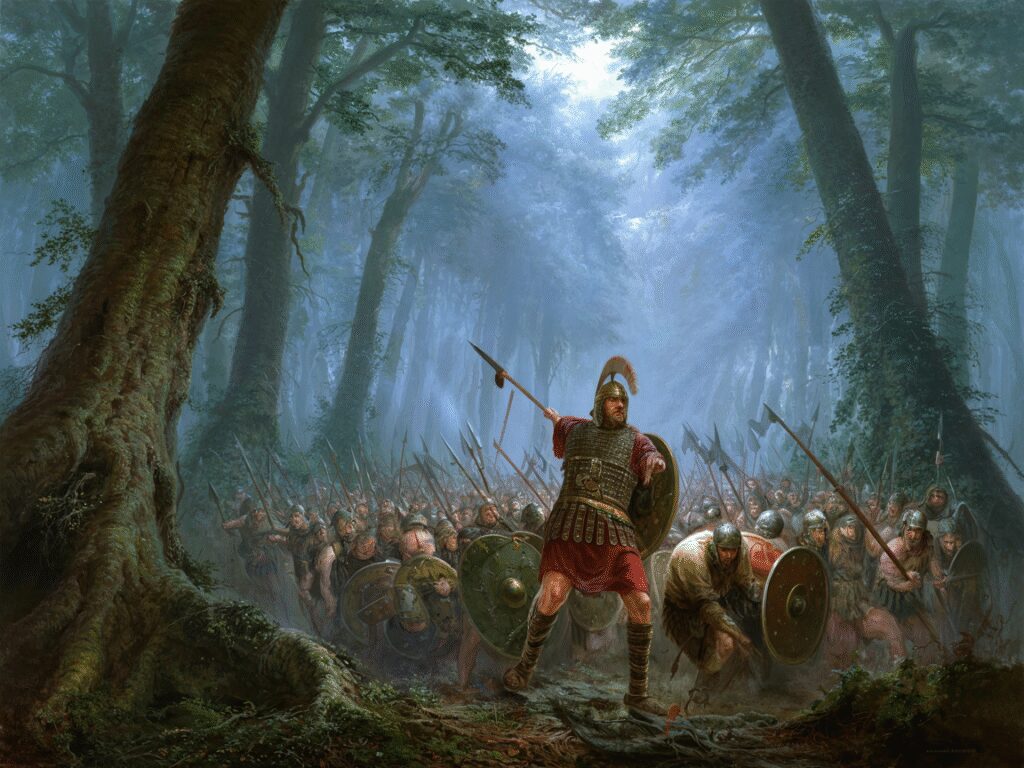When generals revolt in Rome, they do so at the nexus of provincial power, military loyalty, and imperial legitimacy, as seen in the uprisings of Vindex under Nero, Saturninus under Domitian, and Pescennius Niger against Septimius Severus. Each episode reveals how local command of legions, strategic geography, and the politics of succession could destabilize even the most centralized imperial system.
The revolts of Gaius Julius Vindex in 68, Lucius Antonius Saturninus in 89, and Pescennius Niger in 193–194 chart the evolution of military-led challenges from principled provincial protest to full-scale civil war. Vindex’s insurrection helped precipitate Nero’s downfall and the Year of the Four Emperors, Saturninus’s mutiny tested Domitian’s frontier regime, and Niger’s bid for the throne sparked the decisive Severan victory that reshaped imperial rule.
Vindex and Nero
Gaius Julius Vindex, governor of Gallia Lugdunensis and Roman senator of Aquitanian royal lineage, initiated an anti-Neronian revolt in March 68 that catalyzed further uprisings in Spain, Africa, and Egypt. His stated aim, according to ancient testimony preserved by Cassius Dio and summarized by modern scholarship, was to restore the Senate’s dignity and Augustan norms rather than to claim the purple himself. Vindex coordinated with Servius Sulpicius Galba in Hispania, seeking a suitable replacement for Nero while rallying Gallic support against the emperor’s excesses and abuses.wikipedia+1
Vindex’s field army marched to confront forces loyal to Nero under the governor Verginius Rufus, culminating in the clash near Vesontio (Besançon) in late May or early June 68. The battle, remembered as Vesontio, ended disastrously for the Gaul-led coalition and led to Vindex’s suicide after his troops were routed by the Rhine legions. Even so, the shock of the rebellion helped unravel Nero’s support in Rome, pushing him toward suicide and igniting the rapid succession crises of 69 CE.wikipedia+2
The significance of Vindex lies less in tactical success than in strategic effect: his provincial defiance opened the floodgates of elite and military opposition, transforming localized protest into empire-wide revolution. The Vesontio defeat thus paradoxically advanced Vindex’s political objective by delegitimizing Nero and setting the stage for Galba’s acclamation and the subsequent power struggles. The episode also underscored the growing capacity of governors in non-militarized provinces to mobilize substantial forces through alliance-building and appeals to Roman civic ideals.

Saturninus revolt
Lucius Antonius Saturninus, a senator and former suffect consul, governed Germania Superior with the powerful legions XIV Gemina and XXI Rapax quartered at Mogontiacum (Mainz). In January 89, he attempted a short-lived usurpation against Emperor Domitian, likely driven by personal animus and local military dynamics rather than a broad ideological program. The chronology and details are partly obscured by his subsequent damnatio memoriae, but both inscriptions and narrative sources place the mutiny at the start of that year.
Saturninus’s plan appears to have included coordination with Germanic allies across the Rhine, but a sudden thaw prevented their crossing and deprived the revolt of external reinforcement at a critical moment. Domitian’s generals, notably Lucius Appius Maximus Norbanus and the future emperor Trajan, responded swiftly, suppressing the revolt before it diffused beyond Mainz. In the aftermath, Norbanus reportedly burned Saturninus’s correspondence to limit the scope of reprisals, although Domitian still executed accomplices and displayed heads on the rostra.
Consequences included the redeployment and possible punitive dissolution of Legio XXI Rapax and a new prohibition against quartering two legions in the same camp, reforms aimed at reducing the risk of concentrated mutiny in frontier provinces. The speed of the revolt’s collapse highlights the importance of environmental contingency, rapid strategic response, and the decisive loyalty of nearby Rhine legions to the reigning emperor. Unlike Vindex’s revolt, Saturninus’s failure reinforced the imperial center’s authority and showcased Domitian’s capacity to reimpose discipline along the northern limes.

Niger vs Severus
The crisis that elevated Septimius Severus and destroyed Pescennius Niger arose from the succession vacuum after Commodus’s assassination on 31 December 192 and the brief, violent reigns of Pertinax and Didius Julianus. In April 193, the Danubian legions proclaimed Severus, while the eastern legions recognized Niger in Syria and Egypt, with Clodius Albinus backed in Britain, producing a tripartite contest for imperial power. Niger controlled critical eastern resources and the Alexandria grain supply, but Severus possessed proximity to Rome and the concentrated striking power of the Pannonian and Upper Danubian forces.
After seizing Rome and eliminating Julianus, Severus moved against Niger’s coalition through a sequence of operations across the Bosporus and Anatolia. Campaigns in late 193 and early 194 saw Severan victories at Cyzicus and Nicaea, culminating in the decisive battle at Issus on 31 March 194. Ancient narratives via Cassius Dio and Herodian emphasize geography and weather at Issus, noting how terrain and storm conditions influenced momentum before Niger’s army broke under coordinated Severan assaults.
Niger attempted to flee eastward toward Parthia but was overtaken and beheaded near Antioch, with his head sent to Byzantium to hasten its capitulation. The fall of Byzantium required a protracted siege, illustrating how strategic fortified nodes could prolong conflict even after the main field army’s destruction. Severus punished cities that supported Niger, reorganized military and provincial commands, and soon launched an eastern war that reinforced his legitimacy and advertised a new martial monarchy.
The Severan settlement emerged from a civil war that privileged the loyalty and mobility of Danubian legions, with Severus subsequently marginalizing the traditional Praetorian Guard and redrawing the political map of imperial power. In contrast to the abortive revolts of 68 and 89, the 193–194 war produced a durable dynastic reconfiguration, embedding military supremacy at the heart of imperial succession. The fate of Niger—damnatio memoriae, annihilation of support networks, and punitive measures against cities—also exemplified the new regime’s harsh consolidation tactics.

Comparative table
| Aspect | Vindex (68) | Saturninus (89) | Niger vs Severus (193–194) |
|---|---|---|---|
| Trigger | Anti-Nero protest invoking senatorial legitimacy and Augustan ideals. | Frontier mutiny by a provincial governor in Mainz, probably personal and opportunistic. | Succession crisis after Commodus, with regional acclamations and competing military coalitions. |
| Key forces | Vindex’s Gallic levy vs Rhine legions under Verginius Rufus. | XIV Gemina and XXI Rapax under Saturninus in Germania Superior. | Danubian legions under Severus vs eastern legions of Syria and Egypt under Niger. |
| Decisive action | Defeat at Vesontio leading to Vindex’s suicide, yet political victory against Nero. | Rapid suppression by Domitian’s generals; thawed Rhine foiled Germanic support. | Severan victories at Cyzicus, Nicaea, and Issus; Niger killed near Antioch. |
| Imperial response | Nero’s position collapses; cascade into Year of the Four Emperors. | Executions, administrative reforms, dispersal/punishment of XXI Rapax, ban on co-camping legions. | Reprisals against cities, siege of Byzantium, eastern campaigns, consolidation of Severan rule. |
| Strategic levers | Alliance with Galba; moral-political claims; limited formal legions. | Localized legions and hoped-for Germanic allies; environmental contingency. | Control of grain routes, fortified nodes, and mobile Danubian strike power. |
Patterns
Three through-lines emerge: the decisive role of legions along the Rhine-Danube corridor, the utility of strategic choke points and fortified cities, and the potency of legitimacy narratives, whether senatorial, dynastic, or popular. Vindex framed revolt as constitutional rectitude, Saturninus bet on swift local force and external allies, and Niger banked on eastern resources and prestige—yet only Severus possessed a combination of proximity, mass, and speed to win a continental civil war. Environmental and geographical variables mattered at Mainz and Issus, reminding that even strong plans can be overturned by thawed rivers or constricted passes.
The management of military concentrations is a consistent theme, as Domitian’s ban on co-camped legions and Severus’s retooling of Rome’s guard echo the state’s need to dilute potential mutiny hubs. Meanwhile, control of Alexandria’s grain and the Bosporus fortified corridor shows how logistics and maritime gateways could decide imperial legitimacy as much as battlefield outcomes. Ultimately, generals who succeeded fused narrative legitimacy with actionable force in the right theater at the right time.

Sources and debates
Ancient narratives from Cassius Dio and Herodian, along with epigraphic evidence and later compendia, provide the scaffolding for these reconstructions, though damnatio memoriae clouds details for Saturninus. Modern summaries indicate Vindex’s aims likely centered on removing Nero rather than secession, but some scholars leave open the extent of Gallic particularism. For the 193–194 campaigns, chronology and battle locations are broadly secure, with Issus on 31 March 194 anchoring the final triumph of Severus in the East.
The Battle of Vesontio is well-attested as the operational endpoint for Vindex’s forces, even as the political effects cascaded in Rome. For Saturninus, the reported burning of letters by Norbanus is frequently cited to explain the limited scope of reprisals and our fragmentary record. In assessing Niger’s coalition, accounts consistently emphasize the initial strength of eastern support and the later severing of lifelines via Egypt and the Tauros passes.
Vindex’s legacy
Vindex became the catalyst, not the claimant, of regime change, opening the door for Galba and the subsequent convulsions of 69 CE. The revolt highlighted the capacity of provincial elites to mobilize moral-political legitimacy against imperial autocracy and to coordinate across provinces. Even in defeat, the insurrection reframed Nero’s rule as untenable and demonstrated the political leverage of regional governors without permanent legionary commands.
The memory of Vesontio and Vindex’s suicide contributed to a Roman cautionary tale: a decisive tactical loss can paradoxically produce systemic political change when the emperor’s prestige is already brittle. In later narratives, Vindex often appears as a transitional figure—neither usurper nor emperor—whose revolt helped redefine the boundaries of acceptable resistance to tyranny. That duality explains enduring interest in his motives, from Senate-first constitutionalism to whispers of Gallic autonomy.

Saturninus’s legacy
Saturninus’s failure served as a case study in how quickly localized revolts could be crushed when imperial communications, neighboring provincial loyalties, and environmental factors converged against the insurgent. Domitian’s administrative responses, including dispersing legions and preventing co-location, show a sophisticated attempt to engineer out structural risks of rebellion in frontier provinces. The episode also elevated the reputations of commanders like Trajan, underlining how suppressing usurpation could be a stepping stone to future prominence.
By limiting the revolt’s spread and performing controlled reprisals, the regime contained political fallout while reinforcing the message that the Rhine armies were the emperor’s backbone. Though Saturninus was erased formally, traces in inscriptions and historical compendia preserve the lesson that even well-positioned governors could not count on external tribal allies or weather. The Mainz mutiny thus became a cautionary frontier tale about the fragility of plans built on frozen rivers and fragile alliances.
Severan reordering
Defeating Niger at Issus allowed Severus to claim a decisive, history-laden victory on the very ground where Alexander had broken a Persian king, reinforcing the aura of rightful conquest. The protracted siege of Byzantium thereafter demonstrated the persistence of eastern resistance and the centrality of fortified maritime chokepoints in late second-century warfare. Severus transformed the empire’s power architecture by privileging battle-hardened Danubian legions and downscaling Praetorian influence in succession politics.
His reprisals against pro-Niger cities and punitive fiscal measures broadcast a new compact: legitimacy would be secured by victory and loyalty rather than senatorial acclaim. Follow-on eastern campaigns against Parthia provided external triumphs to cement internal authority, fusing military success with imperial ideology. This settlement ushered in the Severan dynasty, where the emperor’s identity as commander-in-chief eclipsed older aristocratic norms.

Lessons on revolt
Successful usurpation required three assets: concentrated, mobile force; control of supply corridors; and a compelling legitimacy story that resonated beyond a single province. Vindex lacked sustained force but possessed a powerful narrative that accelerated Nero’s fall, whereas Saturninus had force but no durable coalition, and Niger had both force and narrative but lost initiative and logistics to Severus. Geography and timing were decisive multipliers, with rivers, mountain passes, and coastal gateways shaping operational possibilities as much as troop counts.
The imperial center, learning from each crisis, tried to preempt recurrence by restructuring garrisons, policing communications, and punishing allies of revolt to deter future coalitions. Yet the very measures that constrained frontier mutiny could not prevent capital-centered coups when Danubian armies marched quickly, as the Year of the Five Emperors showed. In this cycle, Roman stability hinged less on constitutional theory and more on whoever could align soldiers, supplies, and symbols most effectively.
Brief historiography
Cassius Dio and Herodian provide narrative frameworks for the Severan conflict, with battle sequences and political motives that correlate with modern reconstructions of the 193–194 campaigns. Vindex’s revolt is crystallized in concise modern syntheses emphasizing the chain reaction from Gaul to Nero’s suicide, even as the Vesontio defeat ended his military bid. Saturninus’s case illustrates the interpretive limits caused by deliberate erasure, leaving scholars to triangulate from scattered references and administrative aftereffects.
While some details remain debated—such as precise legion dispositions or the timing of specific operational movements—the overarching trajectories of each crisis are robustly established. Anchoring dates like Issus on 31 March 194 and events like the Roman entry of Severus into Rome in mid-193 provide the chronological spine for narrative analysis. For 68–69, the sequence from Vindex to Galba to multi-emperor chaos remains one of the best-documented transitions from Julio-Claudian autocracy to Flavian ascendancy.

Conclusion
These three episodes show how Rome’s greatest vulnerability lay in the interplay between provincial command and central legitimacy, with outcomes turning on speed, logistics, and narrative authority. Vindex toppled a tyrant’s image without winning a battle, Saturninus failed at a frontier before his revolt could breathe, and Niger lost a continental war to a rival who mastered the levers of military monarchy. In each case, the empire evolved—not by statute, but by the sword and the stories told about who should wield it.

